From "Navarin" to "Borodino"
In the 90s. XIX century The Russian Empire began the construction of an ocean armored fleet. The main leaders of the country's military leadership were still considered England and Germany, but it was already beginning to carefully look at the rapid growth of the Japanese fleet. During this period, the progress of marine technology and weapons was impressive - the artillery firepower grew, the booking was constantly improved and, accordingly, the displacement and the size of squadron battleships grew. Under these conditions, it was necessary to decide which ships the Russian Imperial Fleet needed to protect the interests of the country, how they would be armed and how they were protected.
NEW GENERATION BRONENOSE
After the construction of a number of "low-standing" battleships in the Naval Ministry decided to build a really powerful armored ship. The design began in January of 1888. It was based on the project of the Emperor Alexander II, but later the designers, creating the ship, began to focus on the German battleship Wörth. The design was completed in April 1889, but the manager of the Marine Ministry, I.A. Shestakov continued to make changes to the draft. Now the ideal was considered the English "Trafalgar". In July, 1889 was built on the “Galerny Island”. The official bookmark took place on 19 on May 1890. The new ship was named the Navarin.
The launch of 8 took place on October 1891 of the city. But during the construction, the “editing” of the project continued. As a result, they installed four 35-caliber 305-mm guns on it, which proved themselves well on the Black Sea armadillos. It was decided to abandon the foremast. The designers have placed four chimneys on the Na-Varina. Completion was delayed for four years due to the delay in the supply of weapons, armor, ship systems and mechanisms. In winter, the work was hindered by severe frosts. Only in October, 1893 was transferred to Kronstadt for the completion of work. 10 November 1895, though without the towers of the main caliber Navarin, went to sea for testing. They were accompanied by finishing work, the elimination of marriage and the installation of weapons. The fifth Baltic battleship entered service in June 1896 g. He was sent to the Mediterranean Sea, and then to the Far East. 16 March 1898. He arrived in Port Arthur and became the flagship of the Pacific Squadron.
The “Emperor Alexander II” was also originally taken as the basis for the design of the sixth Baltic battleship, but its size quickly grew. When designing, they again looked back at Trafalgar. As a result, the battleship of the new generation was designed. These works began in 1890, and continued until January, 1891. Construction began in July, 1891, in the shed of the New Admiralty. The official bookmark took place on 7 on May 1892 in the presence of Emperor Alexander III. The ship was called "Sisoy the Great." But the rework and improvement of the project continued. This was reflected in the pace of construction, which caused many difficulties. But he was the first Russian battleship to receive an 40-caliber 305-mm gun. 20 May 1894. He was launched in the presence of Alexander III. The completion of “Sisoi the Great” was delayed for another two years, only in October of 1896, he began official trials. Not completing them, in November 1896, the battleship was sent to the Mediterranean Sea. The international position required the presence of significant forces of the Russian fleet.
The first voyage of Sisoi revealed numerous defects and defects. 15 March 1897, a training artillery firing took place near the island of Crete, and when fired from the left stern 305-mm gun in the tower, an explosion occurred. The roof of the tower by the force of the explosion was thrown on the nasal bridge. 16 people died, 6 were fatally injured, 9 injured. Repair, repair and elimination of defects was carried out in Toulon. The works lasted until December 1897. After that, the “Sisoy the Great” was hastily sent to the Far East, where the situation worsened. 16 March 1898. He arrived in Port Arthur with Navarin.
The presence of two new Russian battleships allowed us to protect the interests of our country in the Pacific without a fight. Thanks to the “battleship diplomacy”, the Russian Empire gained the right to rent the fortress of Port Arthur. Both battleships took an active part in suppressing a boxing uprising in China in 1900. They were in the roadstead of the Taku fortress, and their amphibious companies fought ashore. The military command decided to repair and upgrade the battleships. In the Far East, the Russian fleet had several bases, but none of them could provide full repair and modernization of ships.
Then in St. Petersburg decided to work in the Baltic. 12 December 1901 g. "Navarin" and "Sisoy the Great", together with "Emperor Nicholas I", the cruisers "Vladimir Monomakh", "Dmitry Donskoy", "Admiral Nakhimov" and "Admiral Kornilov" left Port Arthur. These veteran ships formed the basis of the Pacific squadron, their crews were the most experienced. The combat potential of the squadron had to be restored almost from scratch. This significantly weakened our naval forces in the Far East.
MAIN CALIBR OF RUSSIAN BATTLESHIPS
In October, the 1891 at the Obukhov plant began designing a new 40-caliber 305-mm gun. It was an instrument of a new generation; it was created under the charges of smokeless powder, did not have trunnions and for the first time a piston lock was used on it. They provided a high initial velocity of the projectile, greater firing range and better bro-impenetrability. They had a higher rate of fire. The length of the barrel 12,2 m, the weight of the gun with the shutter 42,8 t. The first gun of this type was tested in March 1895, the serial construction led Obukhov plant. From 1895 to 1906, it was these guns that became the main weapon of the Russian squadron battleships installed on ships of the Poltava and Borodino, Retviza, Tsesarevich and Black Sea battleships. This weapon made them one of the strongest ships in the world. On Navarin, four 305-mm guns were complemented with 8-X152-mm, 4-X75-mm and 14-X37-mm guns. 6х152-mm, 4х75-mm, 12-X47-mm and 14-X37-mm guns were placed on Sisoe Veliky. For battleships of the “Poltava” type, designers for medium caliber (8х152-mm) provided for the first time two-turrets, they were supplemented with 4х152-mm, 12-X47-mm and 28-X37-mm guns. Retvizan, in addition to 4x305-mm, received 12x152-mm, 20х75-mm, 24х47-mm and 6х37-mm guns. At Tsesarevich, the average caliber (12х152-mm) was placed in the towers, it was supplemented by 20х75-mm, 20х47-mm and 8-X37-mm guns. On the battleships of the Borodino type, an average caliber (12х152-mm) was also placed in the towers. Armament also supplemented 20x75-mm 20x47-mm, 2x37-mm guns and 8 machine guns.
However, in 1891-1892. The development of a new 45-caliber 254-mm gun began. She was conceived as one for ships, coastal batteries and ground forces. This unification has led to numerous shortcomings of the new instrument. The length of the gun 11.4 m, piston lock weighed 400 kg. The weight of the gun with the lock ranged from 22.5 t to 27,6 t. Construction of the guns was carried out by the Obukhov plant. Despite the shortcomings, it was decided to install it on the battleships of the Peresvet type and the battleships of the coastal defense. This decision weakened the Russian fleet. Confusion in artillery battleship systems began again, which complicated the supply of ammunition to the fleet.
SERIAL CONSTRUCTION IN THE PETERSBURG VERFIANS
In 1890, a new shipbuilding program was adopted. As a prototype for new armored ships, the designers used the “Emperor Nicholas I” project. But the management again made significant changes to the project, they took into account the latest achievements of technical progress. The ship grew in size, for the first time the main and medium caliber guns were placed in the towers. A number of ideas were borrowed from the construction of Sisoi the Great (reservations, etc.). It was decided to lay a series of three ships in the fall of 1891. Work began on their construction at two St. Petersburg factories. The official laying took place on 7 in May 1892 on the New Admiralty was laid down by the Poltava, on the Galerny Island the battleships Petropavlovsk and Sevastopol. The launching of the Poltava took place on October 25 1894, after three days they launched Petropavlovsk. "Sevastopol" went on the water 20 in May 1895. The completion of the ships was delayed for several years due to various reasons. The first to test out was Petropavlovsk (October 1897), the Second (September 1898) Poltava, and the third in October 1898 Sevastopol. At that time, the situation in the Far East sharply deteriorated again, and the naval leadership tried to send the battleships to the Pacific Ocean as soon as possible. Petropavlovsk (March 1900) came first in Port Arthur. Poltava and Sevastopol (March 1901) followed it. These armadillos formed the basis of the Pacific squadron.
In 1894, the leadership of the Marine Ministry decided to build a series of "light battleships." It was decided to weaken their armament and booking, but due to this increase the speed and range of navigation, improve seaworthiness. It was planned that they would act both on enemy communications, and together with the squadron. In the documents they were often called "armadillos-cruisers". It was decided to build two battleships one at the Baltic Plant (Peresvet) and one at the New Admiralty (Oslyabya). Their construction began in the autumn of 1895. The question of replacing 254-mm with 305-mm guns was discussed several times, but in this case the readiness of ships was disrupted. The official laying of the battleships took place on November 9 1895. On May 7, 1898 was launched, Peresvet was launched, and on October 27, Oslyabyu. The construction, equipping and arming of ships began, but the deadlines were still disrupted. The Peresvet was put to the test in October 1899. At the same time, the military leadership decided to build a third ship of this type, the Victory. The question was even considered of the fourth battleship, but the decision was not made. The construction of Victory began in May at 1898 at the Baltic Shipyard. Her official bookmark took place on 9 February 1899. 17 May 1900, the ship was launched, and in October 1901, "Victory" was put to the test. “Oslyabya” was under construction for the longest time and entered the tests only in 1902, but then later various corrections and additions continued. The rest of the battleships had already arrived in the Far East, and Oslyabya had not yet left the Mark-Zovoi Puddle. Peresvet arrived in Port Arthur in April 1902. Victory took part in the coronation celebrations of the English King Edward VII in May 1902. In July 1902 she participated in a parade on Revel's raid in honor of the visit of the German squadron. She came to the Pacific Ocean only in June 1903. And Oslyabya was still in the Baltic. Only in July, 1903, he went to the Far East with the cruiser "Bayan". But in Gibraltar, the battleship struck an underwater rock and damaged the hull. He was docked in Spices for repairs. After the damage was repaired, the long-suffering ship became part of Rear Admiral A.A. Virenius, who slowly followed to the Far East.
Disadvantages "armadillos-cruisers" caused a lot of complaints. They were eliminated in the third series of the Baltic battleships. She became the biggest of all history Russian Imperial Navy - planned to build five ships. The project "Tsesarevich" was taken as a basis. It was processed by shipbuilder D.V. Starlings The series was planned to be built at three St. Petersburg factories. In May, 1899 began work on the construction of the first ship of the series at the New Admiralty. His official bookmark took place on 11 on May 1900 in the presence of Emperor Nicholas II. The ship was named "Borodino". 26 August 1901. The lead ship went into the water. In October, 1899 on the Galerny Island took up the second ship, which was given the name Eagle. It was launched on July 6. 1902. The construction of the battleships proceeded rhythmically, all the questions that were raised were resolved fairly quickly. The construction of ships began - the most difficult stage for domestic factories. It stretched for several years and by the beginning of 1904, these works were still ongoing. Only the beginning of the war with Japan accelerated the completion. At the Baltic Shipyard, as the largest and most modern Russian enterprise, it was decided to build three series ships. The first of these was the "Emperor Alexander III", the official laying of which was held on 11 in May 1900. 21 in July 1901. It was launched in the presence of Emperor Nicholas II. In October, the battleship 1903 came to tests in the Gulf of Finland. The assembly of the second ship began immediately after the descent of the previous one. This organization of work has reduced the slipway to 14 months. The official bookmark of “Prince Suvorov” was 26 August 1901, and already 12 September 1902, he was launched. In pace of completion, he overtook both Borodino and Eagle. After the descent of the second ship, the construction of the third, the Glory, began immediately. It was officially laid on 19 in October 1902, and it was launched on 16 in August 1903. But after the start of the war, the building froze, and it went into service only in 1905. Construction of a series of Borodino-type battleships factories were able to build squadron battleships on their own, but time was already lost.
WE'RE GETTING HELP US
Making sure that domestic shipyards are not always able to build such huge and complex warships like squadron battleships within the agreed timeframe, the military leaders decided to place part of their orders abroad. The military leadership believed that this would allow the program to be executed on time and achieve superiority over the Japanese fleet. Meanwhile, the country's military leadership has adopted a program “for the needs of the Far East.” In a short time it was planned to build a large number of battleships, cruisers and destroyers. Overseas factories were supposed to help the Russian Empire maintain parity. Unfortunately, these expectations were met only in one of two cases. One of the first orders was an order placed at the American shipyard of Charles Henry Crump in Philadelphia. The overseas industrialist received a contract for the construction of a cruiser and a squadron battleship with a total value of $ 6,5 million. The Retvizan battleship project was developed based on Peresvet and Prince Potyomkin-Tavrichesky drawings. Work on the construction of the ship began in the fall of 1898 g. The official bookmark passed 17 July 1899 g. Advanced American technology significantly reduced the pace of construction. Already 10 October 1899 g. "Retvizan" launched on the water. The battleship came out in August 1901. 30 April 1902, he left America and crossed the Atlantic Ocean. In the Baltic, he managed to take part in a parade on the Revel roadstead in honor of the visit of the German squadron. In Port Arthur, the newest battleship arrived in April 1903. Retvizan was considered the best battleship of the Pacific Squadron.
The second order for the construction of a squadron battleship was received by the French shipyard "Forge and Chantier" in Toulon. The amount of the contract for its construction exceeded 30 million francs. The project was based on the French battleship Zhorehibieri, which the designer Antoine-Jean Ambal Lagan “fitted” to the requirements of the customer. The official bookmark of the “Tsesarevich” was held on 26 in July of 1899. Initially, construction proceeded at a fairly rapid pace, but often the work was interrupted due to urgent matters on other orders. The hull was launched on 10 in February of 1901. But during the construction numerous problems arose and, like at the Russian shipyards, it stretched for several years. Only in November 1903, the “Tsarevich” arrived in Port Arthur. This experience has shown that the order of warships at foreign shipyards is not always justified, and domestic factories could cope with their construction much faster.
BONNOANTS IN THE FIRE OF THE "SMALL VICTORY OF WAR"
At the end of 1903 and the beginning of 1904, the Russian military leadership, who incorrectly assessed the situation in the Far East, did not take urgent measures to hastily reinforce the Pacific squadron. It counted on the fact that our naval forces are sufficient to ensure the supremacy of the sea, and Japan would not risk a conflict. But negotiations on controversial issues were interrupted, and the Japanese leadership gathered to resolve them by force. At that time, a detachment under the command of Rear Admiral A.A. was on the way to the Far East. Virenius. It consisted of the battleship Oslabya, 3 cruisers, 7 destroyers and 4 destroyer. With their arrival at Port Arthur, our forces would get a finished look: 8 battleships, 11 cruisers of the 1 rank, 7 cruisers of the 2 rank, 7 canlodos, 2 minelayer, 2 mine cruisers, 29 destroyers, destroyers They were based in Port Arthur and Vladivostok. But with the outbreak of hostilities in St. Petersburg, it was decided to return the ships of the Virenius detachment to the Baltic, and not to attempt to break through to Port Arthur or Vladivostok. The Japanese, in turn, were able to successfully transfer from the Mediterranean to the Far East two new armored cruisers, which greatly strengthened their fleet. In January-March, the Russian leadership did not take any real measures to speed up work on the completion of the Borodino-type battleships. Everything changed only after the death of "Petropavlovsk". But time was lost.
The war against the Land of the Rising Sun began on the night of January 27 1904, when several detachments of Japanese destroyers attacked Russian ships that were on the outer roads of Port Arthur. Their torpedoes hit the strongest ships of the squadron battleships Retvizan and Tsesarevich. They received serious damage, but did not die, thanks to the heroic actions of rescue parties. January 27 morning they met on the coastal shallows at the entrance to the fortress. In this form, the damaged battleships took part in the first battle with the Japanese fleet, which approached Port Arthur. Our weakened squadron was helped by fire by the coastal batteries of the fortress, and the exchange of fire ended in a draw. In the course of the battle, Petropavlovsk, Pobeda and Poltava suffered minor damage. After the end of the battle, the squadron gathered on the inner raid of the fortress and began to “lick their wounds”, only the Retvisan remained on the shallows. It was necessary to urgently repair the damage to the battleships, but there was no large dock in Port Arthur, it was just being built. Russian engineers found a way to repair the ships used caissons. The Japanese did not sit on their hands and on the night of February 11 decided to destroy Retvizan. To do this, they used firefighters. But our sailors repelled their attack and sank five ships. The battleship did not receive damage, it began to be unloaded quickly in order to remove it from the bank. This was accomplished only on February 24 on the day of the arrival in the fortress of Vice Admiral SO Makarov, who was appointed the new squadron commander.
Under Makarov, the squadron began active operations on the 35 days of its command, the squadron went to sea six times, the ships made evolutions and maneuvers, and the coast reconnaissance was started. In the campaigns of the squadron Makarov raises his flag on the "Petropavlovsk". Correction of damaged ships accelerated, work began on Retvisan and Tsesarevich. 8 and 9 March, the Japanese fleet tried to fire at Port Arthur, but the Pobeda and Retvisan fires prevented him. March 13 during maneuvers "Peresvet" hit the stern of the "Sevastopol" and bent the blade of the right propeller, which had to be repaired with the help of a diving bell. March 31, the flagship battleship Petropavlovsk explodes on the outer raid of Port Arthur on Japanese mines. On it were killed: the commander of the squadron, 30 officers of the ship and staff officers, 652 lower ranks and the battle painter V.Vereschagin. It was a real disaster, she demoralized the Russian sailors. The situation was aggravated by the detonation of the Victory mine, which took 550 tons of water, but returned safely to the fortress. She began to repair, for this was again applied to the caisson. At the same time, work continued on the "Cesarevich" and "Retvisan", the damage to the "Sevastopol" was corrected. After the death of Makarov, the squadron again ceased to go to sea and began to barrels in Port Arthur.
The Japanese took advantage of the lull and landed their troops at Bitszyo. Thus, they cut off Port Arthur from Manchuria and blocked it. Soon the Japanese units began preparations for the assault. The amphibious companies of sailors took an active part in repelling the attacks. From the ships of the squadron hastily brought all the machine guns and landing guns. Armadillos said goodbye to part of their artillery, which began to install on arthurskih positions. By June 1 the squadron ships lost: 19х152-mm, 23х75-mm, 7х47-mm, 46х37-mm, all machine guns and 8 searchlights. Then the governor ordered to prepare the squadron for a breakthrough to Vladivostok, and these guns began to hastily return to the squadron ships. By 9 June, all repair work on Victory, Tsesarevich and Retvizane was completed. The ships took on board coal, ammunition, water and food. On the morning of June 10, the entire squadron began to leave the fortress. But because of the trawling her exit was delayed. In the sea, she was met by the Japanese fleet and the squadron commander Rear Admiral V.К. Witgeft refused to fight. He decided to abandon the breakthrough and return to Port Arthur. Thus, a real opportunity was missed to go to Vladivostok and begin active operations. On the way back, “Sevastopol” hit a mine, but was able to return to the fortress.
While with the help of a caisson they corrected the damage of the “Sevastopol”, the squadron ships began to be attracted to the support of the Russian troops. “Poltava” and “Retvizan” went out to the sea several times. The Japanese brought the siege weapons and from 25 July began daily shelling of Port Arthur. There were several hits in the "Tsesarevich" and "Retvizan." Rear Admiral V.K. Witgefta was wounded by a shell fragment. On July 25, the work at Sevastopol was over, and the squadron began to prepare for a breakthrough again. Early in the morning of July 28, the ships left Port Arthur. In 12.15, the general battle began, which was called the battle in the Yellow Sea. For several hours the opponents fired at each other, there were hits, but not a single ship sank. The outcome of the battle decided two hits. In 17.20, a Japanese shell hit the lower part of the foremast of the Cesarevich and showered the bridge of the battleship with fragments. Wit-geft was killed, and the squadron lost command. In 18.05 projectile hit the lower bridge, its fragments fell into the conning tower. The battleship lost control, failed, described two circulations, and cut through the formation of the Russian squadron. Our ships lost their command, broke the line, and became a bunch. The Japanese covered them with fire. The situation was saved by the commander of the battleship Retvizan, captain 1, rank E.N. Schensnovich, who sent his ship in the direction of the Japanese. The enemy focused fire on him, the rest of the squadron ships got a breather, rebuilt and turned to Port Arthur. In this battle, Retvizan, Sevastopol and Poltava suffered the most. The damaged Tsesarevich and a number of other ships left for neutral ports, where they were interned and disarmed.
Returning to the fortress, the battleships began to repair the damage. By early September, they were eliminated, but at the meeting of the flagships they decided not to make new attempts to break through, but to strengthen the defense of the fortress with guns and seamen. 10 August "Sevastopol" went to Tahe Bay to bombard the Japanese positions. On the way back, he again hit a mine, but was able to return to Port Arthur under its own power. This was the last outing of the battleship of the Arthur squadron at sea. 19 September the Japanese conducted the first bombardment of the fortress from 280-mm siege mortars. Each such weapon weighed 23 t, it fired a projectile at 200 kg at 7 km. These shelling became daily and it was they who destroyed the Russian squadron. The first victim of the “little ones from Osaka” was “Poltava”. She was shot on November 22. After a strong fire, the ship sat on the ground in the West Basin of the fortress. November 23 killed "Retvizan", November 24 - "Victory" and "Relight." Only "Sevastopol" survived and in the evening of November 25 left the fortress to the White Wolf Bay. He continued shelling the Japanese positions. He was attacked by Japanese destroyers, destroyers and mine boats for several nights in succession, but to no avail. Battleship defended anti-torpedo nets and booms. Only 3 December they managed to damage the battleship torpedoes. He had to put astern on the ground, but he continued to fire. The last shooting of the main caliber he spent December 19. December 20 "Sevastopol" was flooded on the outer roadstead of Port Arthur. The fortress was surrendered to the Japanese.
By this time, on the way to Port Arthur was the second Pacific squadron under the command of Rear Admiral Z.P. Christmas. The basis of its combat power was the four newest squadron battleships of the Borodino type. For the sake of their hasty completion and speedy commissioning, it was necessary to freeze work on the fifth ship of the series. By the middle of the summer of 1904, all work on them, in general, was completed. Only the readiness of the Eagle, which on May 8 lay on the ground in Kronstadt, was lagging behind. Armadillos began to pass tests and make their first trips along the Marquise Puddle. Due to the rush of wartime, the testing program of the latest armadillos was reduced. Their crews passed only a short course of combat training and began to prepare for the campaign. On August 1, the squadron commander raised his flag on the flagship battleship “Prince Suvorov”. It included 7 squadron battleships, 6 cruisers, 8 destroyers and transports. On September 26, an imperial review was held at Revel’s raid. October 2, the squadron began an unprecedented campaign in the Far East. They had to go 18000 miles, overcome three oceans and six seas without Russian bases and coal stations along the route. Armadillos of the Borodino type received baptism of fire in the so-called Gull incident. On the night of October 9, Russian ships fired at English fishermen in the North Sea, who were mistaken for Japanese destroyers. One trawler was sunk, five damaged. Five battleships went around Africa, the rest passed through the Suez Canal. On December 16, the squadron assembled in Madagascar. During her stay in Nusib, a number of warships joined her. But the morale of the squadron sailors was undermined the news about the death of the squadron, the surrender of Port Arthur and Bloody Sunday. March 3, the squadron left the island and headed to the shores of Indochina. Here, on April 24, ships of Rear Admiral N.I. Nebogatova. Now it was a significant force: 8 squadrons of battleships, 3 coastal battleships, 9 cruisers, 5 auxiliary cruisers, 9 destroyers and a large number of transports. But the ships were overloaded and worn out by a difficult passage. On the 224th day of the campaign, the second squadron of the Pacific Ocean entered the Korea Strait.
In 2.45 14 in May 1905, the Japanese auxiliary cruiser discovered the Russian squadron in the Korean Strait and immediately informed the command. From that moment on, the battle became inevitable. It began on 13.49 with a shot from Prince Suvorov. A fierce firefight began, both sides focused their fire on the flagships. The Japanese broke down under cover, and the Russian ships did not maneuver. Already after 10 minutes after the start of the Oslyabya cannonade, it received significant damage. Large holes were formed in the nose, a strong lurch appeared on the port side, fires began. In 14.40 the ship failed. In 14.50, Oslabya rolled over onto the port side and sank. Part of his crew was saved by destroyers. At the same time, the battleship "Prince Suvorov" went out of order. The steering was interrupted on him, he had a roll on the port side, numerous fires raged on the superstructure. But he continued to fire on the enemy. In 15.20, Japanese destroyers attacked him, but they were driven away. Next, the squadron led the course NO23 "Emperor Alexander III." The Japanese concentrated on him all the power of their fire, and in 15.30 the burning battleship failed with a roll to the left side. Soon he extinguished the fires and returned to the convoy headed by Borodino. Now he experienced the full power of the Japanese fire, but soon the battle was interrupted due to fog. In 16.45, "Prince Suvorov" again attacked the enemy destroyers, one torpedo hit the port side. In 17.30, the squadron destroyer “Violent” approached the burning battleship. He managed, despite the strong excitement, to take down the wounded commander and also the 22 man. There were still sailors on the huge burning armadillo, but they decided to do their duty to the end.
In 18.20, the fight resumed. The Japanese focused their fire on Borodino. In 18.30, “Emperor Alexander III” emerged from the column, which turned over in 20 minutes and sank. On the water in the place of the death of the battleship left a few dozen sailors. They tried to save the cruiser "Emerald", but he was driven off by fire the enemy. Not a single person escaped from the crew of the Emperor Alexander III. He became a mass grave for 29 officers and 838 lower ranks. The Russian squadron was still led by Borodino. On it raged several fires, he lost the mainmast. In 19.12, one of the last volleys of the battleship Fuji was covered and received a fatal hit. 305-mm shell hit the area of the first tower of medium caliber. The hit caused the detonation of ammunition and the battleship sank instantly. Of his crew, only 1 people escaped. At Borodino, the officer 34 and the lower rank 831 died. At this time, the Japanese destroyers attacked the Prince Suvorov. The flaming flagship fired from the last 75-mm gun, but several torpedoes hit it. So died the flagship of the second Pacific squadron. Of the remaining sailors on it, no one escaped. Killed 38 officers and 887 lower ranks.
In the daytime battle, the Russian squadron suffered defeat; the battleships Oslyabya, Imperator Alexander III, Borodino, Prince Suvorov and the auxiliary cruiser were sunk, many ships suffered significant damage. The Japanese have not lost a single ship. Now the Russian squadron was to withstand the attacks of numerous destroyers and destroyers. The squadron continued to follow the course NO23, led by the “Emperor Nicholas I”. Late and damaged ships were the first to become victims of mine attacks. One of them was the "Navarin". In the daytime battle, he received several hits: the battleship sat with his nose and had a roll on the port side, one of the pipes was knocked down, the speed dropped sharply. Around 22.00 a torpedo hit the stern of the Nava-rina. The roll rose sharply, speed dropped to 4 nodes. Around 2 hours of the night a few more torpedoes hit the battleship, it rolled over and sank. There are many sailors left on the water, but because of the darkness no one saved them. Killed 27 officers and 673 lower ranks. Only the sailor's 3 was saved. “Sisoy the Great” suffered a large fire on the day before it, there was a big fire, there was a significant lurch to the port side, the stroke dropped to 12 nodes. He lagged behind the squadron and independently repelled the attacks of the destroyers. A torpedo hit the 23.15 stern. The ship ceased to be controlled, there was a strong roll on the starboard side. Sailors brought a plaster under the hole, but the water kept coming. The commander directed the battleship to the island of Tsushima. Here the Japanese ships caught up with him and raised a signal for surrender on the Sisoe Veliky. The Japanese visited the ship, but he was already lurching. Around 10 of the morning the battleship rolled over and sank.
At around 10 in the morning hours on May 15, the remains of the Russian squadron were surrounded by the main forces of the Japanese fleet. In 10.15, they opened fire on Russian ships. Under these conditions, Rear Admiral N.I. Nebogatov ordered the descent of the St. Andrew flags. The battleships Orel, Emperor Nicholas I, and two battleships of coastal defense surrendered to the Japanese. 2396 man was taken prisoner. It was this episode that became the symbol of the defeat of the Russian fleet at Tsushima.
- Alexey Tsarkov, magazine "Weapon"
- The beginning of the era of steam and armor
"Peter the Great" and others
From "Navarin" to "Borodino"
Black Sea armadillos: from "Popovok" to "Potemkin"
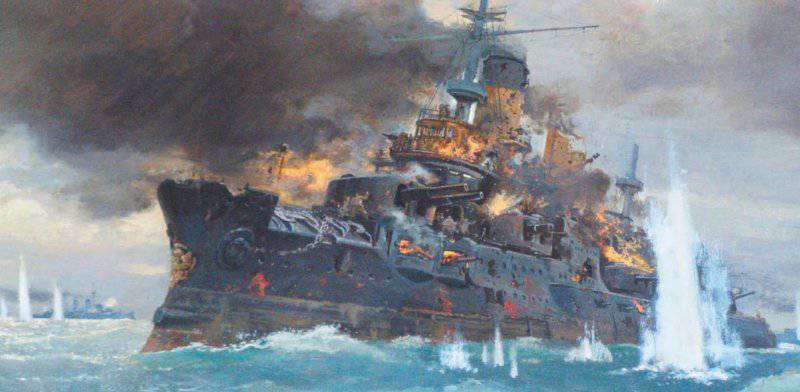
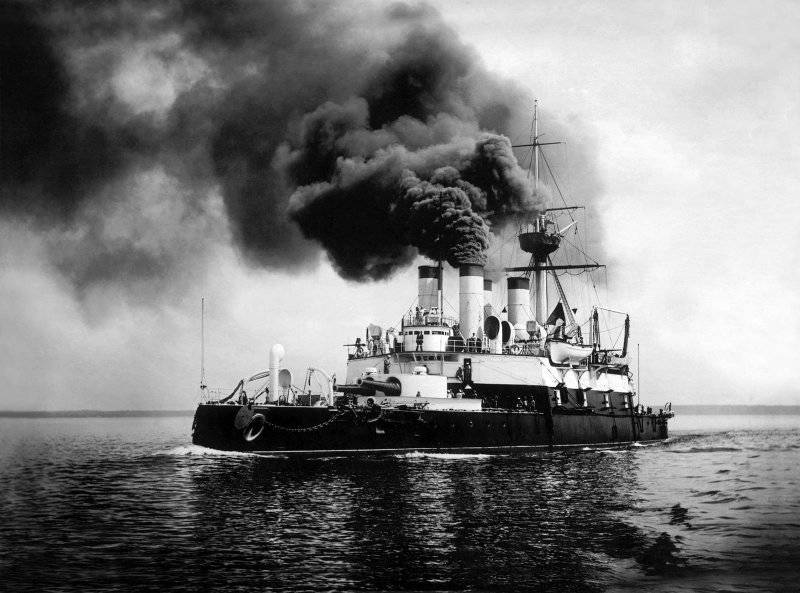
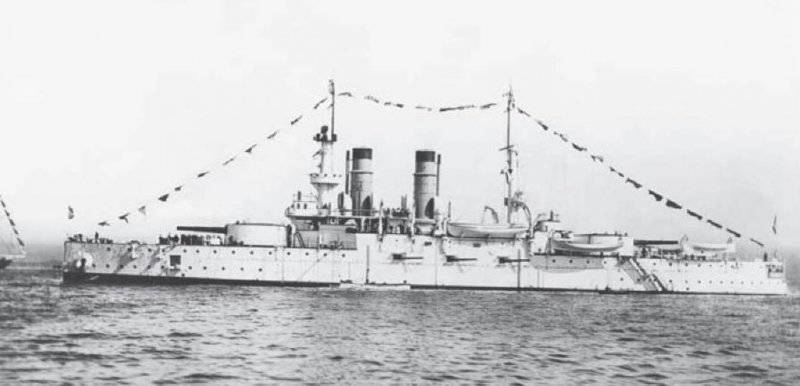
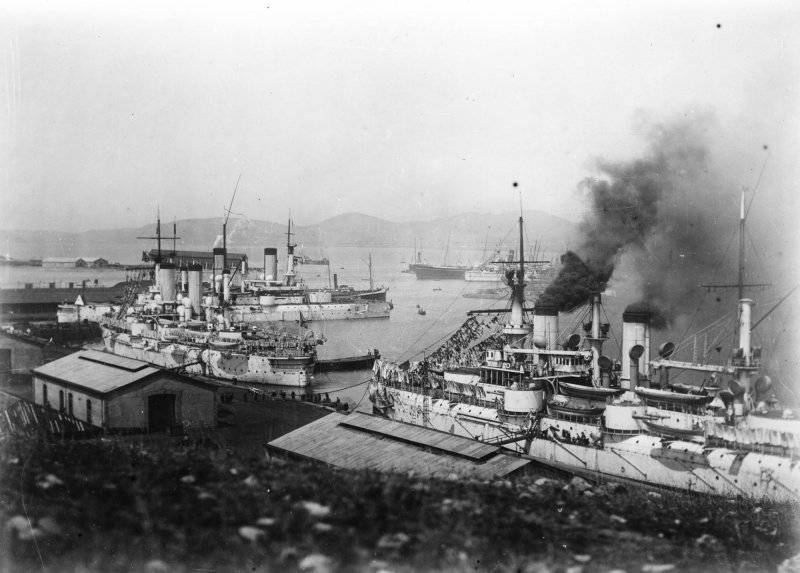
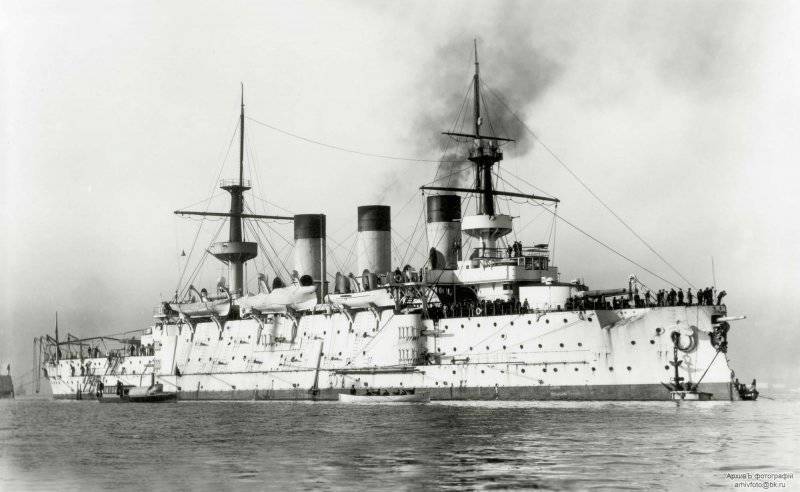
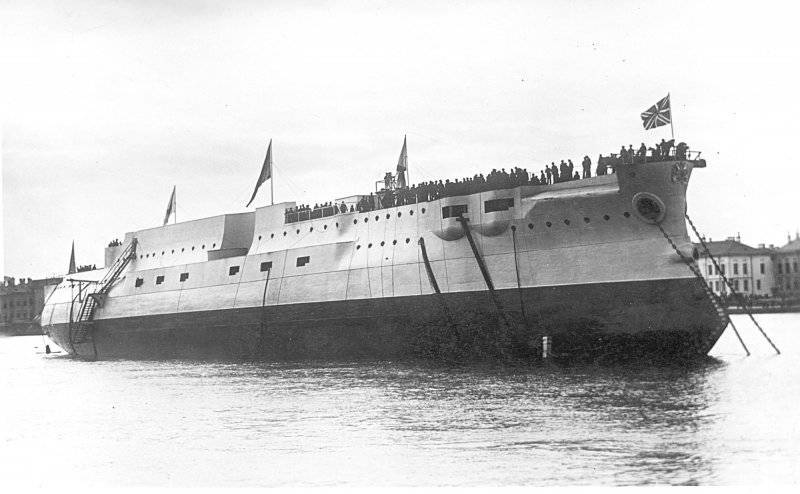
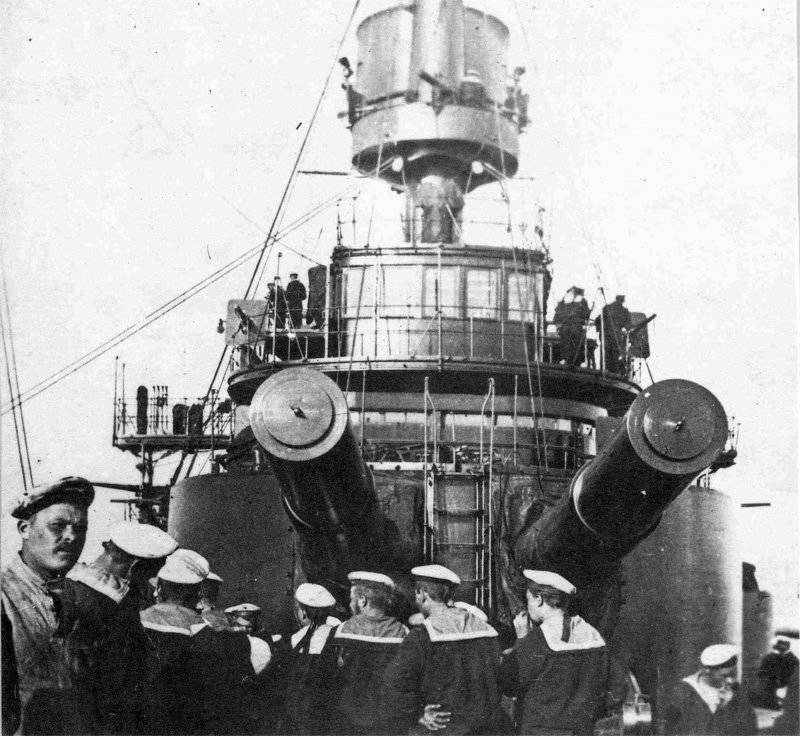
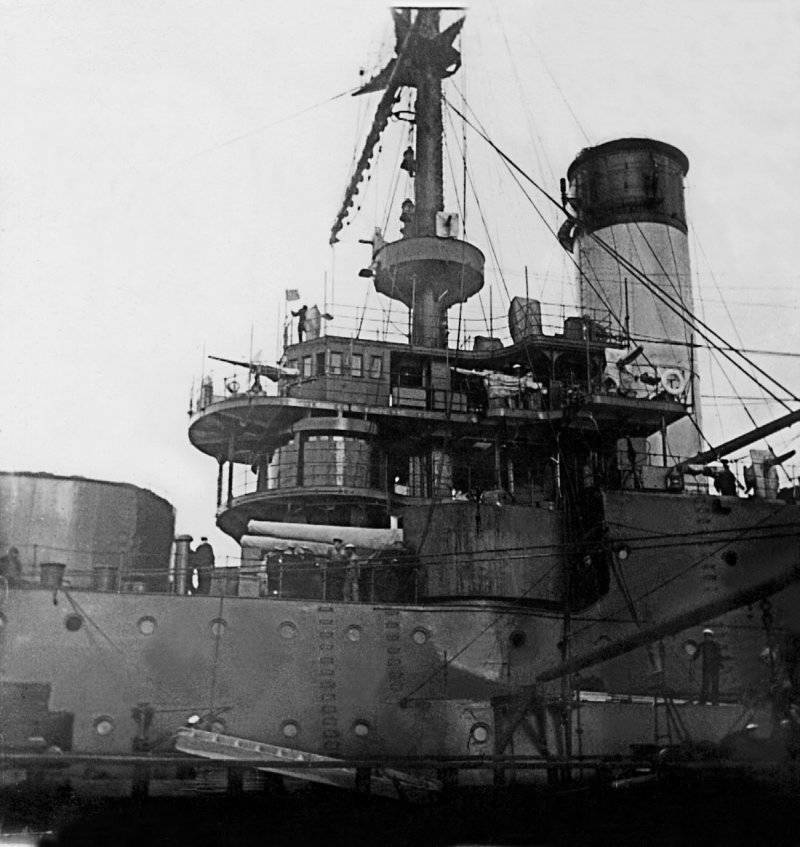

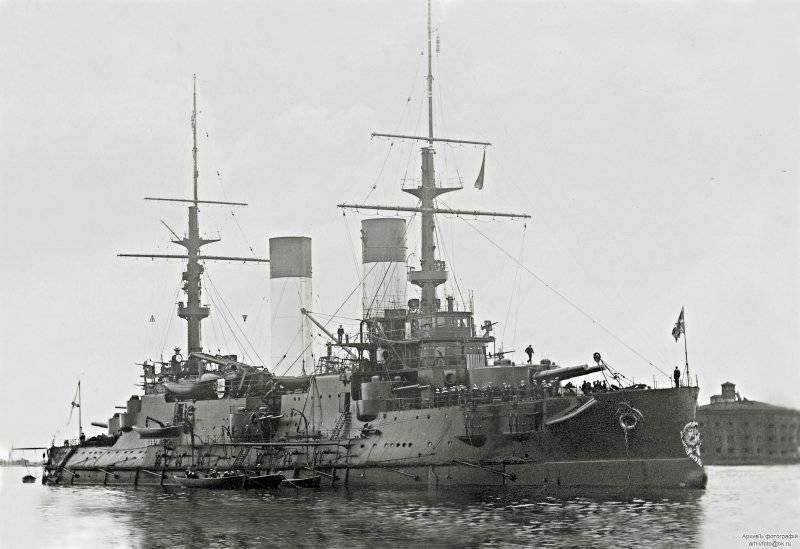
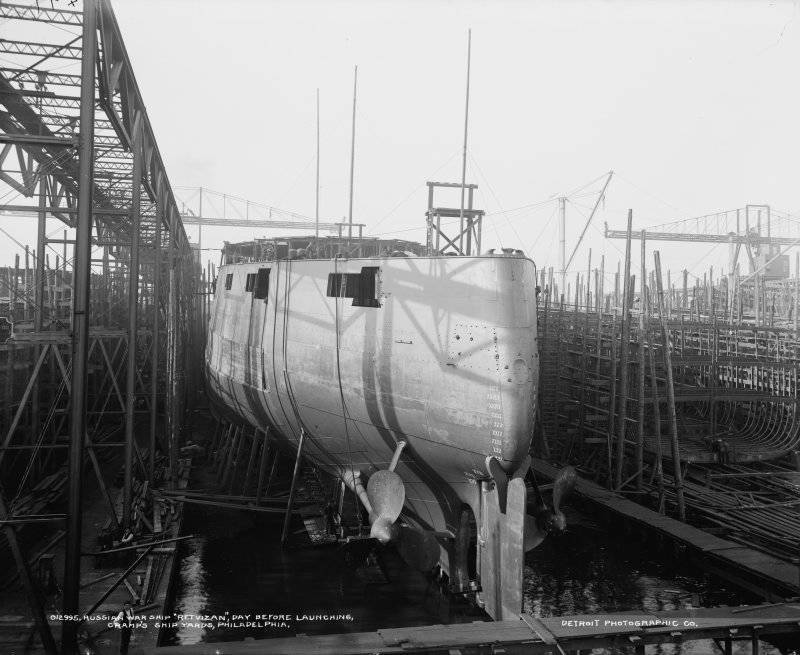
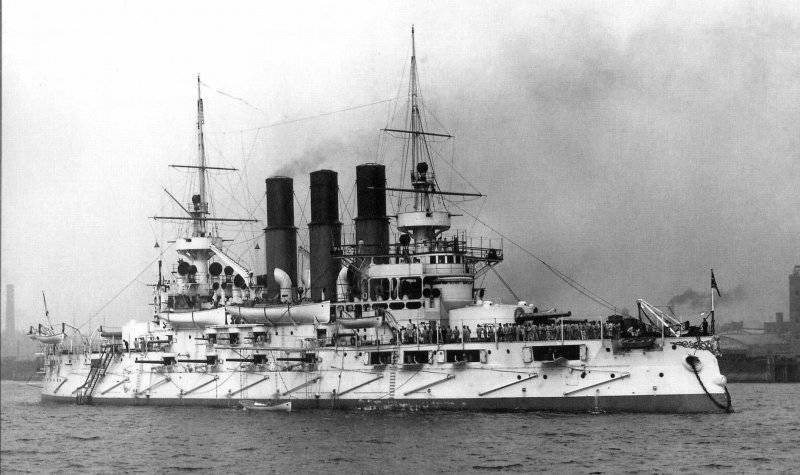
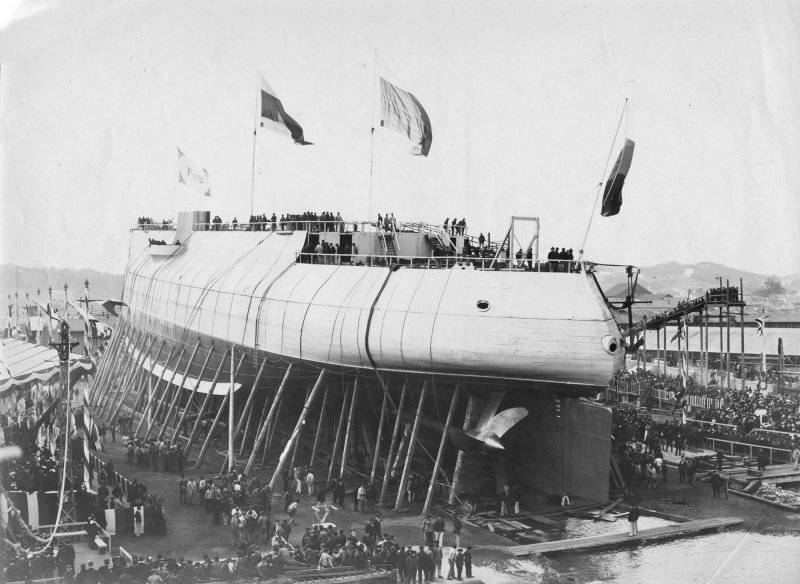
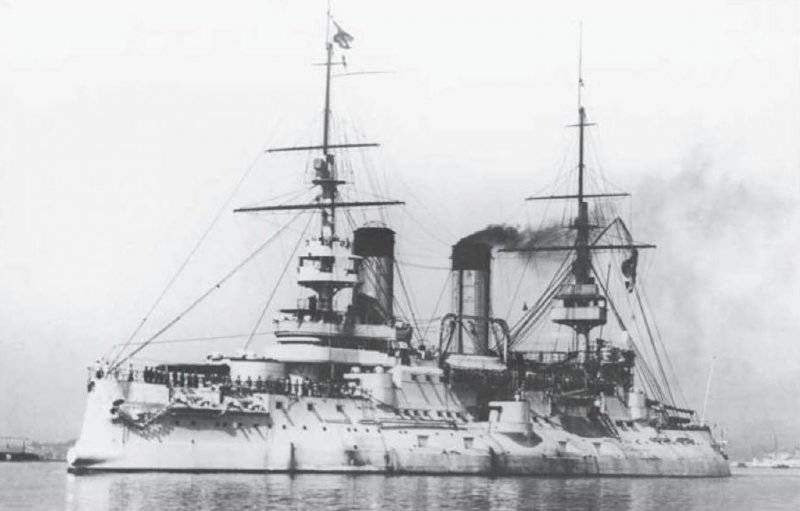
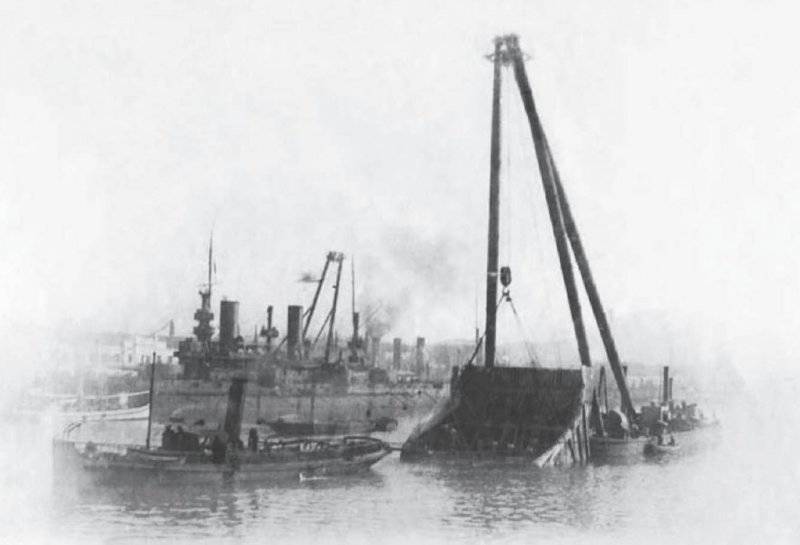
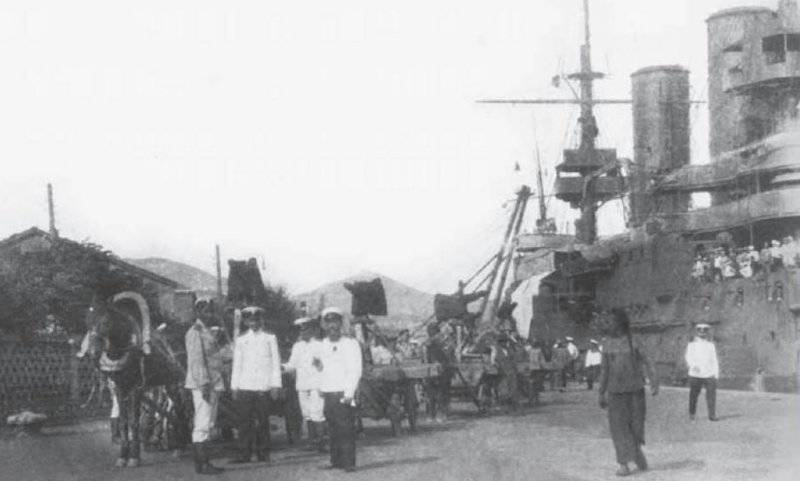
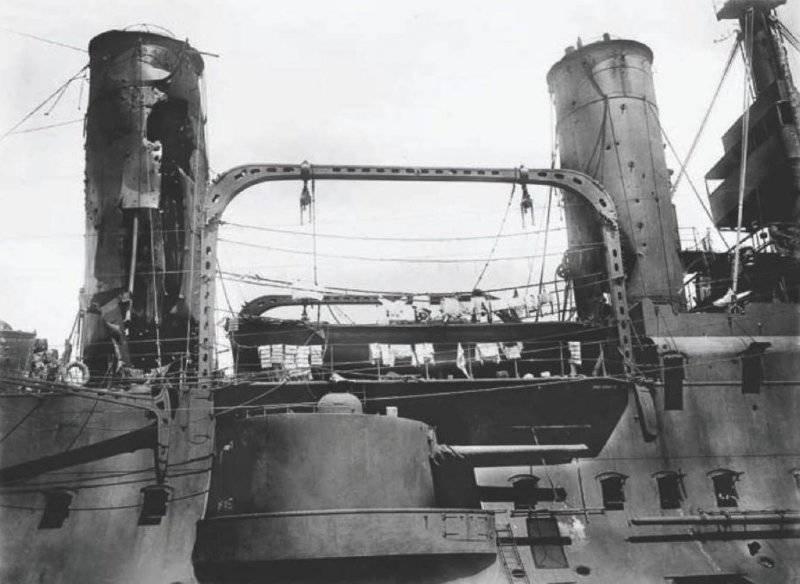
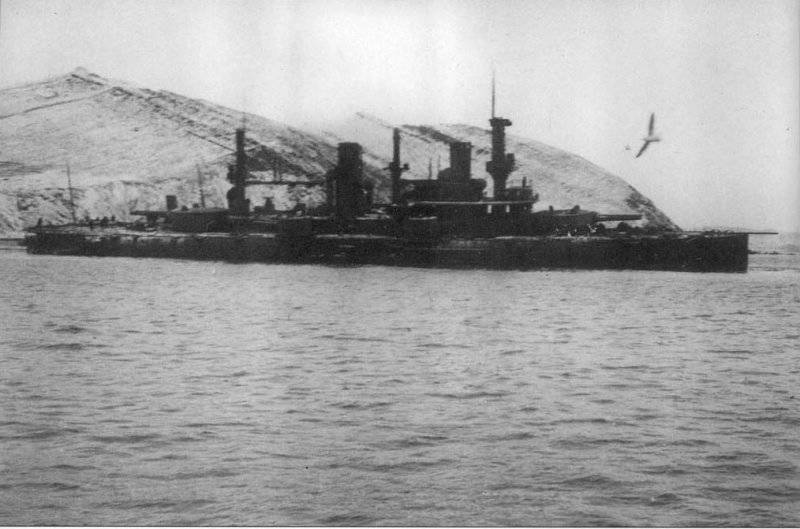
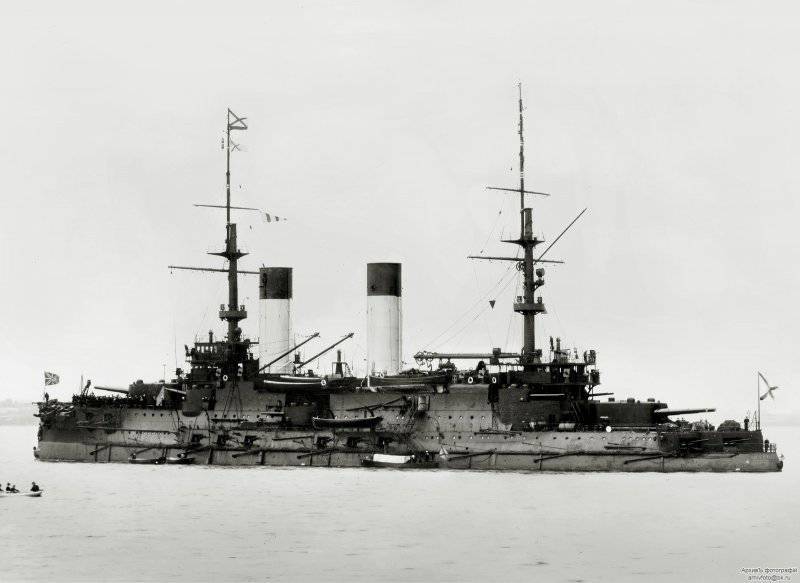
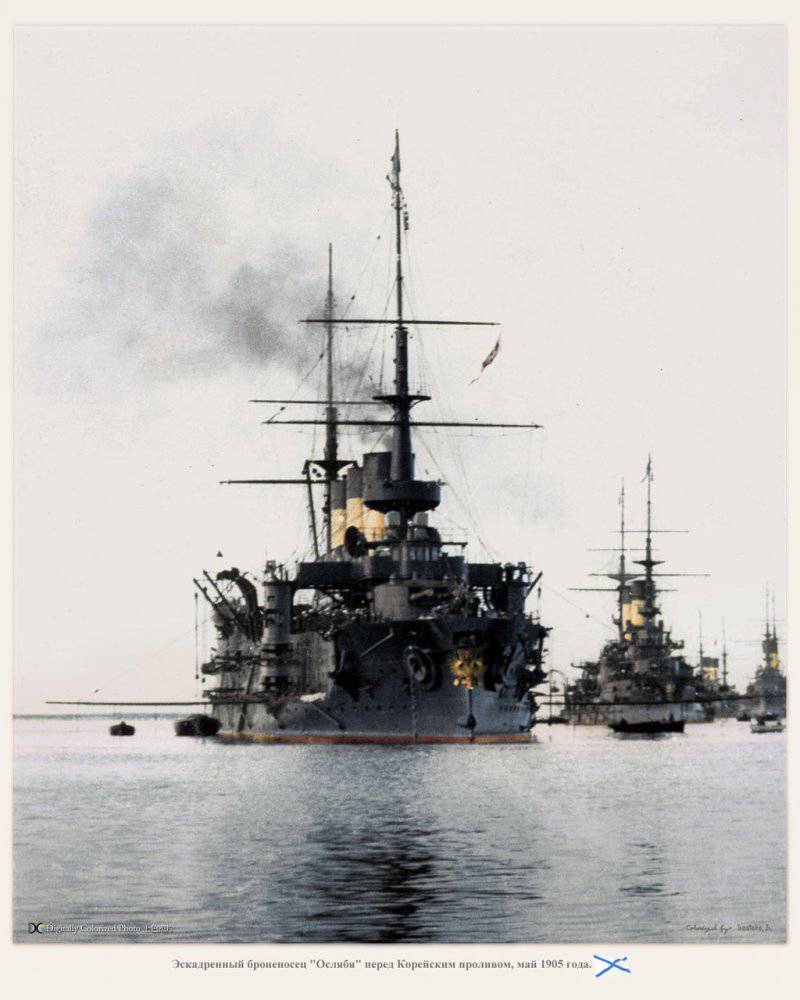
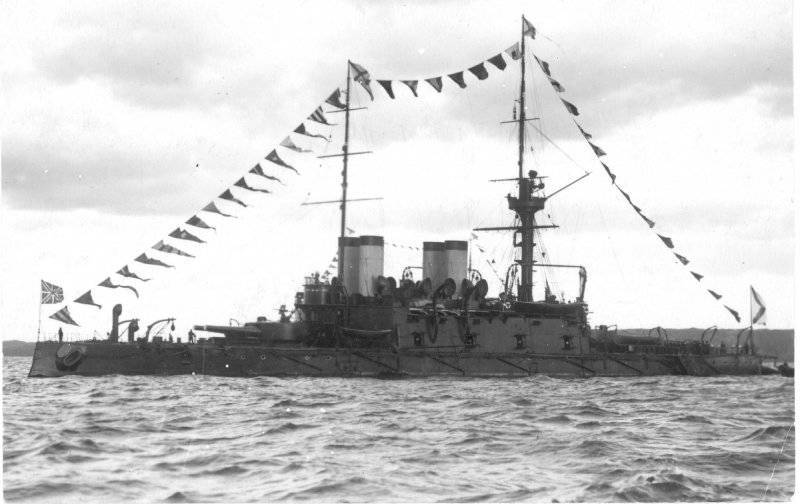
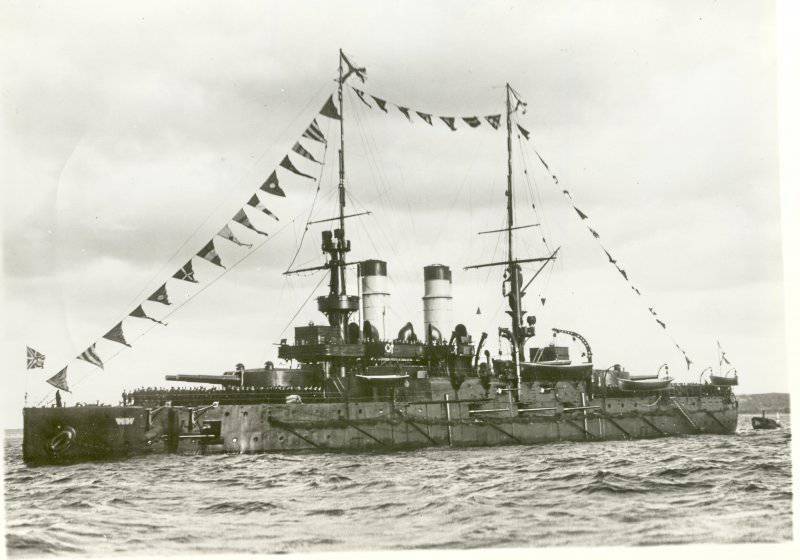
Information